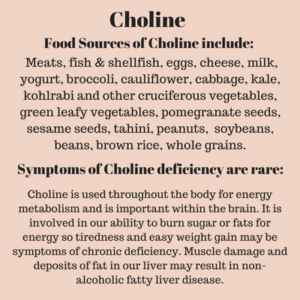Choline is a newer discovery in the nutrient world. It is considered to be a member of the water soluble B vitamins group which are nutrients involved in metabolism – the use of energy within the body. We can produce small amounts of choline so it isn’t considered a vitamin but as we can not produce enough for health it is considered an essential nutrient. (1) Betaine is a slightly different form of choline. Choline is found throughout the body but is particularly important within the brain and is needed for the neurotransmitter acetylcholine. Betaine is a metabolite of choline.

Choline is most typically found within phospholipids (such as phosphatidylcholine) which are important in membranes and as messenger chemicals within the brain and in the immune system. It may play a role in prenatal brain development but research on supplementation within pregnancy r to protect cognitive skills in the elderly is still in early stages. (1)
Choline is a methyl donor (1) which means it can share a methyl group – essentially one carbon atom with three hydrogen atoms with an overall neutral charge.
An important role of methyl groups is in the release of energy from sugar within mitochondria. The methyl group is passed back and forth between nutrients and enzymes that are involved in breaking down a molecule of fat or sugar for use of the stored energy that is released when a double bond is broken. The methyl group is combined with an acetyl group when it is removed from the area on the chain of carbon molecules when a double bond is broken. An acetyl group is an atom of carbon combined with one atom of hydrogen and the group has a negative charge. The process for breaking down the glucose sugar molecule is called the Krebs cycle and most beginning level organic chemistry or nutrition students will remember having to memorize all of the steps involved. My summary may be inaccurate – college was a long time ago – the important point is that B vitamins and methyl donors are needed for mitochondria to be able to release energy from glucose/sugar molecules).
- (The Krebs cycle is also known as the “citric acid cycle or the tricarboxylic acid (TCA) cycle.” More info: Krebs cycle.)
Methyl groups are also important in controlling gene activity. They act like an on/off switch for genes. A gene that is fully methylated – all the available double bonds between carbon atoms are broken into single bonds with a methyl group added instead – is in the off position, the protein that the gene would encode is not being made. Genes that are unmethylated have double bonds and are in the on position, the pattern for assembling amino acids into a protein can be read by a matching strand of RNA and the protein can be formed (generally in the endoplasmic reticulum or Golgi apparatus areas of a cell).
Betaine and the more familiar B vitamins folate (B9 if anyone is counting), B6 and B12 are also methyl donors. Folate deficiency has been associated with less gene methylation (a histone is part of a gene). (2) More about methyl donors as a group is available here: Methyl Donors and BPA.
- The number system for naming B vitamins was derived at an earlier stage of research and some of the chemicals that were given numbers at the time were discovered to not be essential nutrients – meaning the body was able to form them within the normal health and didn’t essentially need to have them included in the diet (so that is why we don’t hear about a B4, B8, B10 or B11).
Excessive intake of choline above 7500 milligrams may cause a drop in blood pressure, sweating, vomiting and digestive upset, and change in body odor. The recommended Upper Limit is 3,500 mg/day. It would be difficult to reach that amount with food sources. (Safety information, lpi.oregonstate.edu)
Food Sources of Choline:
Good sources of choline include meats, fish & shellfish, eggs/egg yolks, cheese, milk, yogurt, broccoli, cauliflower, cabbage, kale, kohlrabi and other cruciferous vegetables, green leafy vegetables, pomegranate seeds, sesame seeds, tahini, peanuts, soybeans, beans, brown rice, whole grains.
Food Sources of Betaine:
Sweet potatoes, meats, cheese, beets, basil, spinach, green leafy vegetables, brown rice, whole grains.
Disclaimer: Opinions are my own and the information is provided for educational purposes within the guidelines of fair use. While I am a Registered Dietitian this information is not intended to provide individual health guidance. Please see a health professional for individual health care purposes.
References:
- Choline, Linus Pauling Institute, Oregon State University, http://lpi.oregonstate.edu/mic/other-nutrients/choline
- Benjamin A. Garcia, Zigmund Luka, Lioudmila V. Loukachevitch, Natarajan V. Bhanu, Conrad Wagner, Folate deficiency affects histone methylation,
Medical Hypotheses, Volume 88, March 2016, Pages 63-67, ScienceDirect, https://www.sciencedirect.com/science/article/pii/S0306987716000116
- Foods used in the 30% Calories from Carbohydrates Menu Plans, https://effectiveselfcare.info/2018/05/19/healthy-hair-is-the-proof-of-a-healing-diet/
